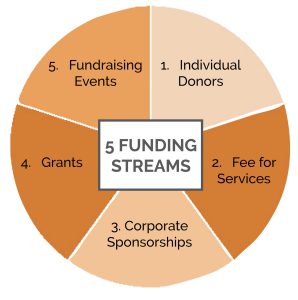Did you know that a majority (90%) of non-profit organizations rely on a single source for 90% of their funding? How do I start fundraising to diversify?

When we work with clients to help increase their funding, we typically recommend that they diversify their funding. When an organization is strongly reliant on fees for service or grants, we help them determine what other funding sources might be a good fit based on their industry, community, and organizational capacity.
We often find that many non-profit organizations, especially those with smaller budgets (under $1 million), do not have a strategic fundraising strategy. Fundraising simply means partnering with individuals and organizations to support your cause. It can be a great method to supplement your existing funding (fees for service, grants, and contracts) that might be stringent about how you can provide services.
As a non-profit organization, how do you approach fundraising? Recently, we have worked with a few organizations to help them diversify and increase their funding to grow their programs and impact. Below are some strategies that we use that you could apply today!
1. Set a Goal
The first step is to set a goal for how much you need to raise from your fundraising efforts and how this will support your organization. For example, we worked with an early childhood education center that was expanding its services to a new location. They were seeking funding to support the renovation and start-up costs of this new facility and were able to determine the total costs they needed from individuals and organizations to supplement their existing funding.
Put a finite number (a specific dollar amount) to your plan and develop a clear message for how that funding will be spent. This is what will excite individuals and organizations to partner with you!
2. Create a Plan and Timeline
Now that you have a fundraising goal, you need to create a plan describing your steps. The plan does not need to be complicated, so don’t let that hold you back. The plan should be like any project plan. It will describe the different funding sources, and the amount you believe is realistic for you to secure to reach that goal. Who is responsible (we will get to “who” in the next step), and when will they accomplish it?
For example, if you want to raise $100,000, then you’re plan may look like the following:
- $25,000 – Fundraising Events (you will hold 5 events that will raise $5,000/ event)
- $50,000 – Individual Donors (a combination of small and large gifts)
- $25,000 – Corporation Sponsors (you will get 5 corporations to sponsor at $5,000/ event)
- Your plan should be customized to the assets in your organization. If your organization is well connected / well known and has strong relationships in the community, then perhaps you can raise more money from individual donors. Maybe your organization is well organized and could put events together easily with volunteers, so you could generate more money through events. The purpose here is to be specific and realistic about what is possible with your organization’s capacity and resources.
3. Develop a Team
When your organization begins to embark on fundraising as part of its revenue strategy, it is a team effort. It cannot be the sole responsibility of your Executive Director or Development Director. To accomplish your fundraising goal, you will need an army of champions and supporters who are working together (hence the need for a plan!).
At a minimum, your team should include your staff (not just those at the helm), board of directors, and funders. Depending on your fundraising goal and current organizational capacity, you may need to form a special ad hoc committee to lead this fundraising campaign. The goal here is to excite your team about why you want to raise this funding, how it will grow your impact, and their specific role in helping you accomplish the goal.
4. Track Your Results
Once you have a plan and put it to work, you must track and monitor how it goes. This process will determine if you meet your goal and inform future fundraising efforts. Tracking your data could look different depending on your activities. For outreach to potential individual donors, you might track the number of outreaches you’ve made and types (emails, open/ click rates of emails, phone calls, events, letters, etc.). This could help inform the # or kind of outreach that seems to be most effective for your donors.
For a fundraising event, we recommend tracking all of the costs, including staff and volunteer time. We often find that a lot of “sweat equity” goes into putting on an event—so much so that sometimes the event does not net any profit when you factor it into the cost. In any event, you want to see your total return on investment after all these costs are included to determine if that is the best use of your time.
The purpose here is to use data to understand what is and is not working, which you can use to pivot your strategies and tactics. We have helped organizations retool a fundraising event to bring in more money or launch a monthly donor campaign to increase cash flow. The goal is to get the most out of your fundraising efforts to accomplish your goals! {Interested in learning more about using data? Check out several other blogs we have written on the topic here!}
In summary, when your organization wants to get started with fundraising, follow these four steps:
- Set a Goal
- Create a Plan and Timeline
- Develop a Team
- Track Your Results
We get excited learning about our clients’ possibilities and the causes they passionately champion. Do you need more help with your fundraising efforts? Give us a call to set up a free consultation on how we could support your goals.

